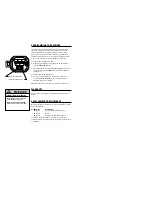
C A U T I O N
C A U T I O N
MOVING PARTS ENTANGLEMENT HAZARD
Failure to observe these instructions could lead to
minor or moderate injury.
General Safety:
•
Always
Know Your Winch. Take time to fully read the
Installation and Operations Guide, and Basic Guide
to Winching Techniques, in order to understand
your winch and its operation.
•
Never
operate this winch if you are under
16 years of age.
•
Never
operate this winch when under the
influence of drugs, alcohol or medication.
•
Never
exceed winch or rope capacity listed on
product data sheet. Double line using a snatch block
to reduce winch load.
•
Never
use winch or rope for towing.
Installation Safety:
•
Always
choose a mounting location that is
sufficiently strong to withstand the maximum
pulling capacity of your winch.
•
Always
use factory approved mounting hardware,
components, and accessories.
•
Always
use grade 5 (grade 8.8 metric) or better
hardware.
•
Never
weld mounting bolts.
•
Always
use care when using longer bolts than those
supplied from factory. Bolts that are too long can
damage the base and/or prevent the winch from
being mounted securely.
•
Always
mount the winch and attach the hook to the
rope’s end loop before connecting the electrical
wiring.
•
Always
position fairlead with WARNING label on top.
•
Always
spool the rope onto the drum in the
direction specified by the winch warning label on
the winch and/or documentation. This is required
for the automatic brake (if so equiped) to function
properly.
•
Always
prestretch rope and respool under load
before use. Tightly wound rope reduces chances of
“binding”, which can damage the rope.
MOVING PARTS ENTANGLEMENT HAZARD
Failure to observe these instructions could lead to
minor or moderate injury.
Winching Safety:
•
Always
inspect rope, hook, and slings before
operating winch. Frayed, kinked or damaged
rope must be replaced immediately. Damaged
components must be replaced before operation.
Protect parts from damage.
•
Never
leave wired remote control plugged into winch
when free spooling, rigging, or when the winch is
not being used.
•
Never
hook rope back onto itself. This damages the
rope.
•
Always
use a choker chain, choker rope, or tree trunk
protector on the anchor.
•
Always
remove any element or obstacle that may
interfere with safe operation of the winch.
•
Always
take time to use appropriate rigging
techniques for a winch pull.
•
Always
be certain the anchor you select will
withstand the load and the strap or chain will not
slip.
•
Never
engage or disengage clutch if winch is under
load, rope is in tension or drum is moving.
•
Always
select an anchor point as far away as
possible. This will provide the winch with its
greatest pulling power.
•
Never
touch rope or hook while in tension or under
load.
•
Never
touch rope or hook while someone else is at
the control switch or during winching operation.
•
Always
stand clear of rope and load and keep others
away while winching.
•
Always
be aware of stability of vehicle and load
during winching, keep others away. Alert all
bystanders of any unstable condition.
•
Never
use a winch to secure a load.
C A U T I O N
C A U T I O N
N O T I C E
C A U T I O N
MOVING PARTS ENTANGLEMENT HAZARD
Failure to observe these instructions could lead to
minor or moderate injury.
Winching Safety:
•
Always
keep wired remote control lead clear of the
drum, rope, and rigging. Inspect for cracks, pinches,
frayed wires or loose connections. Replace remote
control if damaged.
•
Always
pass wired remote control through a
window to avoid pinching lead in door, when using
remote inside a vehicle.
•
Never
leave remote control where it can be activated
during free spooling, rigging, or when the winch is
not being used.
•
Always
require operators and bystanders to be aware
of vehicle and or load.
CUT AND BURN HAZARD
Failure to observe these instructions could lead to
minor or moderate injury.
To avoid injury to hands or fingers:
•
Always
wear heavy leather gloves when
handling a rope.
•
Never
let rope slip through your
hands.
•
Always
be aware of possible hot surface at winch
motor, drum or rope during or after winch use.
MOVING PARTS ENTANGLEMENT HAZARD
Failure to observe these instructions could lead to
minor or moderate injury.
•
Always
use a hook with a latch.
•
Always
ensure hook latch is closed and not
supporting load.
•
Never
apply load to hook tip or latch. Apply load only
to the center of hook.
•
Never
use a hook whose throat opening has
increased, or whose tip is bent or twisted.
AVOID WINCH AND EQUIPMENT DAMAGE
•
Always
avoid side pulls which can pile up rope at one
end of the drum. This can damage rope or winch.
•
Always
ensure the clutch is fully engaged or
disengaged.
•
Never
use winch to tow other vehicles or objects.
Shock loads can momentarily exceed capacity of
rope and winch.
•
Always
avoid “powering out” rope for extended
distances. This causes excess heat and wear on the
winch motor and brake.
•
Always
use care to not damage the vehicle frame
when anchoring to a vehicle during a winching
operation.
•
Never
“jog” rope under load. Shock loads can
momentarily exceed capacity of rope and winch.
•
Never
use winch to secure a load during
transport.
•
Never
submerge winch in water.
•
Always
store the remote control in a protected,
clean, dry area.
•
Always
double line or pick distant anchor point when
rigging. This maximizes pulling power and avoids
overloading the winch.
























